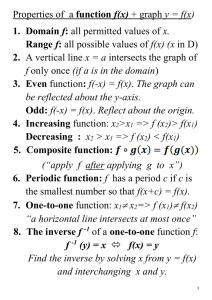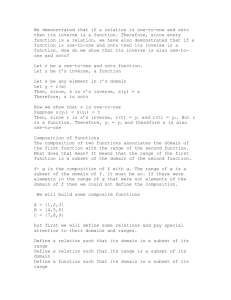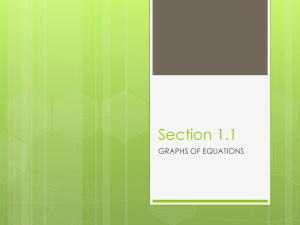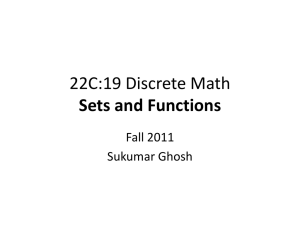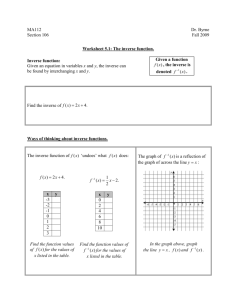Chapter 3 notes
advertisement
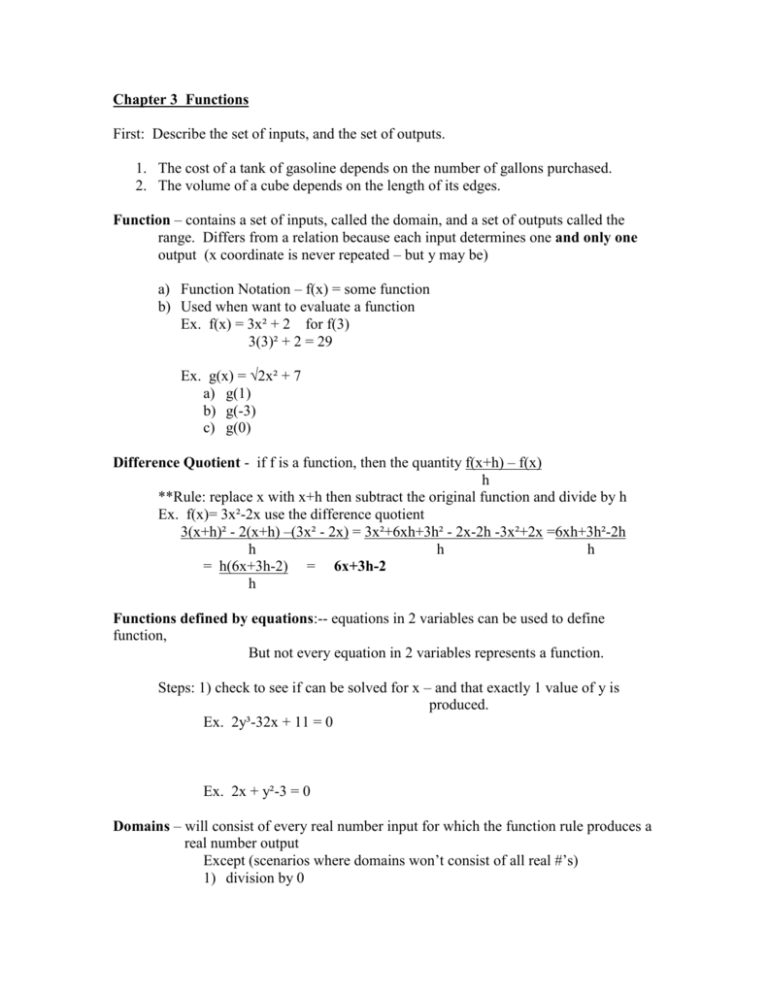
Chapter 3 Functions First: Describe the set of inputs, and the set of outputs. 1. The cost of a tank of gasoline depends on the number of gallons purchased. 2. The volume of a cube depends on the length of its edges. Function – contains a set of inputs, called the domain, and a set of outputs called the range. Differs from a relation because each input determines one and only one output (x coordinate is never repeated – but y may be) a) Function Notation – f(x) = some function b) Used when want to evaluate a function Ex. f(x) = 3x² + 2 for f(3) 3(3)² + 2 = 29 Ex. g(x) = √2x² + 7 a) g(1) b) g(-3) c) g(0) Difference Quotient - if f is a function, then the quantity f(x+h) – f(x) h **Rule: replace x with x+h then subtract the original function and divide by h Ex. f(x)= 3x²-2x use the difference quotient 3(x+h)² - 2(x+h) –(3x² - 2x) = 3x²+6xh+3h² - 2x-2h -3x²+2x =6xh+3h²-2h h h h = h(6x+3h-2) = 6x+3h-2 h Functions defined by equations:-- equations in 2 variables can be used to define function, But not every equation in 2 variables represents a function. Steps: 1) check to see if can be solved for x – and that exactly 1 value of y is produced. Ex. 2y³-32x + 11 = 0 Ex. 2x + y²-3 = 0 Domains – will consist of every real number input for which the function rule produces a real number output Except (scenarios where domains won’t consist of all real #’s) 1) division by 0 2) square root of a - # or nth root when n is even Ex. find the domain for the given function: (write in interval notation) a) f(x) = 3 x+4 b) f(x) = √1 – 3x Piecewise-Defined Function – one whose rule includes several formulas Ex. f(x) 3x² - 5 if x ≥4 2x + 15 if x<3 Find each of the following: F(0)—since 0 is less than 3—2nd rule applies 2(0)+ 15 = 15 F(3.5) F(4) Greatest Integer Function – is a piecewise defined function in which for any # x, round down to the nearest integer less than or equal to x. domain is always all real numbers, and range is the set of integers notation is f(x) = [x] Ex. let f(x) = [x] Evaluate the following: a) f(-209.99) - [-209.99] = -210 b) f(-51) – [-51] = -51 c) f(-5/4) d) f(√10) -----------------------------------------------------------------------------------------------------------3.2 Graphs of functions x coordinate = input Do Ex. 1 p. 150 y coordinate = output Vertical Line Test – a graph in a coordinate plane represents a function if and only if no vertical line intersects the graph more than once. ** remember – this is because a function can’t repeat its x-coordinate Analyzing Graphs: a) Increasing and Decreasing Functions 1) Increasing = if its graph always rises as you move from left to right in interval 2) Decreasing = if its graph always falls as you move from left to right in interval 3) Constant on Interval – if its graph is a horizontal line over the interval Ex. on what interval is the function f(x) = │x+3│- │x│increasing,decreasing,con. b) Local Maxima and Minima – the peaks and valleys of a graph **make sure that your viewing window is adjusted enough to see peaks/valleys Ex. graph f(x) = x³-2.1x²+x+3 and find all local maxima and minima c) Concavity and Inflection points – used to describe the way a curve bends 1. Concave up – for any 2 points in an interval- if the segment that connects them is above the curve 2. Concave down –if the segment is below the curve 3. Inflection Point – a point where the curve changes concavity Ex. Graph f(x) = x³ + 3x²-x find the maxima, minima, intervals where increasing and decreasing, inflection points, where concave up and down Graphs of Piecewise Functions – often discontinuous with jumps or holes, graph each piece separately ex. graph f(x) = 3 for -2 ≤ x ≤ 2 x²-4x for x>2 a) Absolute Value Function – is a piecewise function b/c definition is: │x│= -x if x<0 x if x>0 b) Greatest Integer Function – is a piecewise function b/c each value represents an interval. Ex. graph f(x) = [x]-2 (start by picking intervals, -3≤x<-2, etc) Parametric Graphing – the x-coordinate and y-coordinate of each point on a graph are each given as a function of the third variable, t, called a parameter. The functions that give the rules for the coordinates = parametric equation a) f(t) = (x,y) x = x(t) y = y(t) b) to graph by hand make a table for t, x and y – then plug t into x equation, then t into y equation. Outputs = coordinate point Ex. graph curve given by: x = t-2 y= t² + 3t t -3 -2 x=t-2 y=t²+3t (x,y) 0 1 2 ** to graph in calculator – you must change your mode to parametric 3.3 Quadratic Functions – any polynomial of degree 2, and whose shape is a parabola Axis of Symmetry- a line through the vertex that makes the parabola symmetric Quadratics can be written in 2 forms: 1. Transformation Form f(x) = a(x-h)²+ k a) most useful for finding the vertex, b/c has points (h,k) b) y-intercept = in forms of ah²+k – putting a 0 in for x and getting y c) x- intercepts – put a o in for y and solve for x – are h±√-k/a ex. For function f(x)= -4(x-2)² + 5 – find the vertex, intercepts, graph 2. Polynomial Form f(x) = ax²+bx+c a) most useful for find y-intercept – put 0 in for x y will always = c b) x-intercepts- solution of quad. Eq.- so find by factoring or quad.form c) vertex – use formula h = –b 2a ** once get h, plug into equation to get k Ex. f(x) = x²+4x+5 – find the vertex, x and y intercepts, graph 3. X-intercept form f(x) = a(x-s)(x-t) a) most useful for finding the x-intercepts = set both = 0 and solve (s, and t) b) y intercept – put 0 in for x and solve for y = ast c) vertex- is exactly half way between the x intercepts so x= s + t 2 **to get y coordinate, just plug x into equation Ex. f(x) = -2(x-3)(x+1) find vertex, and intercepts, then graph Changing from 1 form to another: 1. to change form either transformation or x intercept form to polynomial form – distribute and combine like terms. 2. To change either polynomial or transformation form to x intercept form, factor out leading coefficient then factor/use quad.form. to find x intercepts Applications – the vertex of a parabola is a max or min of a function so answers application questions. Ex. Find the dimensions of a rectangular parking lot that can be enclosed with 2400 feet of fence and that has the largest possible area. --let x denote the length and y the width so: Perimeter = 2x + 2y = 2400 solve for y 2y=2400-2x then y = 1200 - x Area = xy plug in: A=x(1200-x)= 1200x - x² Now use formula for vertex: -b -1200 =600 2a 2(-1) Now plug in to get y: y = 1200 – 600 = 600 so vertex = (600,600) 3.4 Graphs and transformations: Parent Functions – a function with a certain shape that has the simplest algebraic rule for that shape. a) b) c) d) e) f) g) h) i) #1. Vertical Shifts Constant f(x) =1 Identity f(x)=x Absolute Value f(x) = │x│ Greatest Integer f(x) = [x] Quadratic f(x) = x² Cubic f(x) = x³ Reciprocal f(x) = 1/x Square root f(x) = √x Cube root f(x) = 3√x g(x)= f(x) + c is graph shifted up c units g(x) = f(x) – c is graph shifted down c units Ex. Graph f(x) = │x│ then graph f(x) = │x│+ 3 then f(x) = │x│-2 #2. Horizontal Shifts g(x) = f(x+c) is shifted c units to left g(x) = f(x-c) is shifted c units to right Ex. Graph: f(x) = x² then graph f(x)= (x-3)² then graph f(x) = (x+4)² #3 Reflection g(x) = f(-x) is the graph reflected across y-axis g(x) = -f(x) is the graph reflected across x-axis Ex. graph: g(x) = x² and g(x) = -x² #4 Vertical Stretches and Compressions: if (x,y) is a point on the graph of f(x) then (x,cy) is a point on the graph of g(x)=c∙f(x) a) if c>1 the graph of f is stretched vertically, away from x axis by factor of c b) if c <1 the graph of f is compressed vertically toward the x axis by factor of c ** main thing to remember – changing y coordinate** Ex. graph f(x) = 2│x│ and h(x) = ½│x│ #5. Horizontal Stretches and Compressions – if (x,y) is a point on the graph of f(x) then (1/cx,y) is a point on the graph g(x) = f(c∙x) a) if c>1 the graph is compressed horizontally toward y axis by factor of 1/c b) if c<1 the graph is stretched horizontally away from y axis by factor of 1/c **main thing to remember – changing x coordinate** Ex. Graph f(x) = 33√3 and g(x) = 3√3 Combining Transformation: for a function of form g(x) = c∙f(a(x-b)) + d, first graph f(x) 1. if a<0 reflect the graph across the y axis 2. stretch or compress the graph horizontally by a factor of │1/a│ 3. Shift the graph horizontally by b units, right if b>0 left if b<0 4. If c<0 reflect the graph across the x axis 5. Stretch or compress the graph vertically by a factor of │c│ 6. Shift the graph vertically by d units up if d>0, down if d<0 Ex. graph g(x) = -(3x -12)² + 2 a)first: rewrite factored out: -(3(x-4))²+2 so know the parent function b) second: compress horizontally by factor of 1/3 c) third: shift 4 units to the right d) fourth : reflect across x axis e) fifth: shift upward 2 units 3.4 Symmetry 3 kinds of symmetry: #1. Y-AXIS symmetry- occurs if the part of the graph on the right side is the mirror image of the part of the graph on the left side of the y-axis. **is symmetric with respect to the y-axis if whenever (x,y) is on the graph, then (-x,y) is on the graph – algebraically replacing x by –x produces equivalent eq. a) So y-coordinates are always the same b)The x-coordinates are opposites of each other c) The y-axis will be a perpendicular bisector between pts. P and Q Ex. verify that y = -2x4 + 3x2 is symmetric with respect to the y-axis Steps: plug in –x wherever there is an x Y = -2(-x)4 + 3(-x)² = -2x4 + 3x² which is equivalent to original Therefore, symmetric about y axis. #2. X- AXIS Symmetry – a graph is symmetric with respect to the x-axis if whenever (x,y) is on the graph, then (x,-y) is also on it. – algebraically this means that replacing y by –y produces an equivalent equation. a) x-coordinates are always the same b) their y-coordinates are opposite of each other c) The x-axis is the perpendicular bisector between pts. P and Q Ex. Verify that y²= x + 2 is symmetric with respect to the x-axis Steps: plug in –y wherever there is a y in the equation (-y)² = x + 2 = y²=x + 2 which is equivalent to original equation So is symmetric about x-axis #3. Origin Symmetry – a graph is symmetric with respect to the origin if whenever (x,y) is on the graph, then (-x,-y) is also on it—algebraically this means replacing x by –x and y by –y produces an equivalent eq a) if a line through the origin and any point P on the graph also intersects the graph at point Q such that the origin is the midpoint of PQ Ex. verify that y = -x³ + 5x is symmetric with respect to the origin 2 Steps: replace x by –x and y by –y, then simplify -y = -(-x)³ + 5(-x) 2 -y = x³ - 5x = y = -x³ + 5x -1 2(-1) (-1) 2 Even and Odd Functions: A. Even Functions – a function f is even if f(-x) = f(x) for every value x in the domain of f. The graph of an even function is symmetric with respect to the y-axis. Ex. f(x) = x4 + x² + 3 f(-x) = (-x)4 + (-x)² = x4 + x² = f(x) is the same f(x) = f(-x) B. Odd Functions – a function f is odd if f(-x) = -f(x) for every value x in the domain of f The graph of an odd function is symmetric with respect to the origin. Ex. f(x) = 4x -f(x) = -(4x) so -f(x) = f(-x) so odd function 3.5 Operations on Functions: ways in which 2 or more functions can be combined to make new functions. 1. Sums and Differences of functions f+g(x) = f(x) + g(x) **is basically combining of like terms f-g(x) = f(x) – g(x) **Domain and Range of sum and difference is all real numbers that are in the domain of each function. Ex. f(x) = √1-x and g(x) = √x² - 1 find the following and domain Find (f+g)(x) = √1-x + √x²-1 **can’t combine any like terms (f-g)(x) = √1-x - √x²-1 **can’t combine any like terms Domain: for a) domain is all x such that 2. Product and Quotient Functions are defined by the following: (fg)(x) = f(x) ∙g(x) and f(x) = f(x) g g(x) Domain for these consist of all real #’s in both the domain of f and g Ex. f(x) = √2x and g(x) =√x²-4 find (fg)(x) and f/g(x) (fg)(x) = √2x(√x²-4) = √2x³ - 8x (f/g)(x) = √2x ∙ √x²-4 = √2x³-8x √x²-4 √x²-4 x²-4 Domain: of f: x≥0 Of g: x≤-2 or x ≥2 Of fg x≥2 Of f/g x > 2 3. Products with a constant function: distribute to each item in function a) domain will be the same as domain of f Composition of Functions – using the output of 1 function as the input of the other ** If f and g are functions then the composite function of f and g is (g◦f)(x) = g(f(x)) the expression g◦f is read “g circle of f” or “f followed by g” order of function – applied right to left (inner to outer) Ex. f(x) = x² + 2x -1 and g(x) = 1 find the following: x-3 a) (g◦f)(-2) b) (f◦g)(4) c) (g◦f)(x) d) (f◦g)(x) Domains of Composite Functions: Let f and g be function. The domain of g◦f is the set of all real numbers x such that: a) x is in the domain of f b) f(x) is in the domain of g Ex. if f(x) = √x-2 and g(x) = x² - 1 find a) g◦f = (√x-2)² - 1 = x-2-1 = x-3 b) f◦g = (√x²-1-2) = (√x²-3) c) domain of g◦f = domain of f is x≥2, the domain of g is all real # - the domain of f(x) is in g, so the domain is x≥2 d) domain of f◦g = domain of g is all real #’s, the values of g(x) that are in the domain of f are :√x²-3≥0 = √x² ≥3 take square root of each side and domain is: x≤-√3 or x≥√3 Expressing Functions as composites taking a composite and breaking into its functions h(x) = √x³-5 write h as a composition of function in two different ways g(x) = √x f(x) = x³ - 5 3.6 Inverse Functions Inverse Function – the result of exchanging the input and output values of a function a) (x,y) is a point on the graph of a function ----- (y,x) is a point on its inverse b) the reflection of the graph of the original function across the line y=x Do. Ex. 1 p. 205 --- just need to reverse coordinates Finding Inverses from an Equation: EX. find g(x), the inverse of f(x) =2x+1 Step 1: write the functions in terms of x and y y = 2x + 1 Step 2: Switch the x and y x= 2y + 1 Step 3: Now solve for y (so presented in function notation) x= 2y + 1 -1 -1 x – 1 = 2y 2 2 so: g(x) = x-1 2 Determing whether an Inverse is a function 1)** every input of the inverse corresponds to exactly one output (x’s can’t be repeated) = one-to-one function ** if the original function is one-to-one, then its inverse is also a function 2) Horizontal Line Test – a function is one-to-one, if and only if no horizontal line Intersects the graph of f more than once Ex. Graph each function below and determine whether the function is one-to-one, a) f(x) = 3x5 -2x4 + 3x³ + x -2 b) g(x) = -.5x³ + x + 1 Let f be a function. The following statements are equivalent: The inverse of f is a function f is one-to-one The graph of f passes the horizontal line test The inverse function, if it exists, is written as f-1 where if: y = f(x) then x = f-1(y) Restricting the Domain: done when a function is not one-to-one. It is possible to produce an inverse function by considering only a part of the function that is one-to-one Ex. Find an interval on which the function f(x) = x²-3 is one to one, and find f-1 on that Interval: Step 1: graph f(x) =x² -3 ** looking at graph see 1:1 on interval [0,∞) Step 2: switch the x and y x = y² - 3 Step 3: solve √x+3 = √y² --- y = ±√x+3 So f-1(x) = √x+3 b/c want the nonnegative coordinates Composition of a Function and its Inverse A one-to-one function f and its inverse function f-1 have these properties: (f-1 ◦f)(x) = x for every x in the domain of f -1 (f◦ f )(x) = x for every x in the domain of f-1 Any two functions having both properties are one-to-one and are inverses of each other. Ex. Let f(x) = 2x 3-x and g(x) = 3x x+2 Use composition to verify that f and g are inverses 3.7 Rates of change When dropping a rock from a high place, the distance the rock travels is given by the function: d(t) = 16t². Fill in the table: Time (t) 0 1 2 3 3.5 4 4.5 5 Distance d(t) Find the distance the rock falls from t=1 to t = 3 In general: the distance traveled from time t = a to time t = b is d(b) – d(a) feet The length of time interval from t = a to t= b is b – a seconds Therefore: average speed = distance traveled Time interval d(b) – d(a) b–a (measured in ft/sec) Ex. Using above formula: find the average speed of the falling rock from t = 2 to t = 5 Overall, average speed is the most familiar example, but in general: Average Rate of Change = change in f(x) Change in x = f(b) – f(a) b–a Ex. a cone-shaped tank is being filled with water. The approximate volume of Water in the tank in cubic meters is V(x) = x³/4, where x is the height of the Water in the tank. Find the average rate of change of the volume of water as The height increases from 1 to 3 meters. Geometric Interpretation: Secant line – a straight line that joins 2 points Secant Line and Average Rate of Change = Average rate of change of f from x=a to x =b f(b) – f(a) b-a will give you the slope of the secant line joining (a, f(a)) and (b, f(b)) on graph f = The difference quotient – used when computing the rate of change over an interval from a to a+h for some small quantity h. The difference quotient allows us to define a formula to determine the average rate for all possible values of h Using the difference quotient to find the average rate of change: f(x+h) – f(x) h Ex. The distance traveled by a dropped object is given by the function D(x) = 4.9x² with distance d(x) measured in meters and time in seconds. Find A formula for the average speed of a falling object from time x to time x+h. Use the formula to find the average speed from 2.8 to 3 seconds. Ex. find the difference quotient of v(x) = x³ to find the average rate of change of The volume of a cube whose side has a length of x as x changes from: a. 4 to 4.1 b. 4 to 4.01 c. 4 to 4.001 Steps: first use the difference formula for x³.

